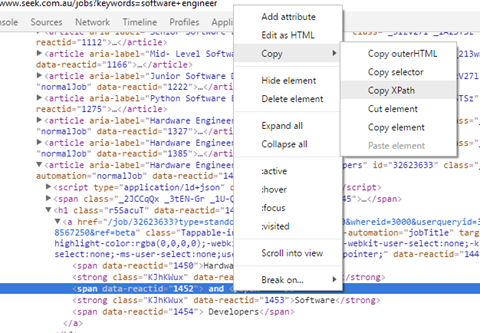Basic Spider with Scrapy
29 Jan 2017This post will explain how to create new scrapy project using command prompt and text editor such as notepad++. Note that it assumes you have already installed scrapy package on your machine, and I am using Scrapy version 1.1.2. See steps below.
- Open command prompt
- Navigate to the directory where you want to create scrapy project e.g. cd c:/users/yohan/documents/python27/projects
- Input
scrapy startproject <project_name>that generates the following structure
- scrapy.cfg
- <project_name>
- _init__.py
- items.py
- pipelines.py
- settings.py
- spiders
- _init__.py
- After that, if you look at ./<project_name> directory then you will find items.py. This will contain the class to hold the scraped information. As an example, I would like to scrape job title and link from seek.com (job listing site) then the item class will look as below in items.py
from scrapy.item import Item, Field
class JobItem(Item):
title = Field()
link = Field()
- Go ahead and create new file called spider.py under ./<project_name>/spiders folder.
- I am going to create a SPIDER to crawl web pages and scrape info in this file. Spider will define initial url e.g. https://www.seek.com.au/jobs?keywords=software+engineer. It also defines how to follow links and pagination, and how extract and parse the field. Spider must define 3 attribute name, start url, parsing method. test.py has a spider class that includes the aforementioned attributes. This class has parsing method which takes the response of page call then parse info using xpath().
from scrapy import Spider
from scrapy.selector import Selector
from quick_scrapy.items import JobItem
class JobSpider(Spider):
name = 'jobs'
allow_domains = ['seek.com.au']
start_urls = [
'https://www.seek.com.au/jobs?keywords=software+engineer'
]
def parse(self, reponse):
titles = reponse.xpath('//article')
items = []
for each in titles:
item = JobItem()
item["title"] = each.xpath('@aria-label').extract()
item["link"] = each.xpath('h1/a/@href').extract()
print item['title'], item['link']
return items
- When / is used at the beginning of path /a, it will define an absolute path to node ‘a’ from the root. When // is used at the beginning of path //a, it will define a path to node ‘a’ from from anywhere in xml response.
- Input
scrapy crawl jobs (spider name) -o out.json, Scrapy will make a call to the url and the response will be parsed
[
{
"link": ["/job/32678977?type=promoted&tier=no_tier&pos=1&whereid=3000&userqueryid=36d7d8b41696017af4c442da6bbf62e8-2435637&ref=beta"],
"title": ["Senior Software Engineer as Tester"]
},
{
"link": ["/job/32635906?type=promoted&tier=no_tier&pos=2&whereid=3000&userqueryid=36d7d8b41696017af4c442da6bbf62e8-2435637&ref=beta"],
"title": ["Software Designer"]
},
{
"link": ["/job/32691890?type=standard&tier=no_tier&pos=1&whereid=3000&userqueryid=36d7d8b41696017af4c442da6bbf62e8-2435637&ref=beta"],
"title": ["Mid-Level Software Developer (.Net)"]
},
...]
- You can easily find xpath of html element as below

See source code